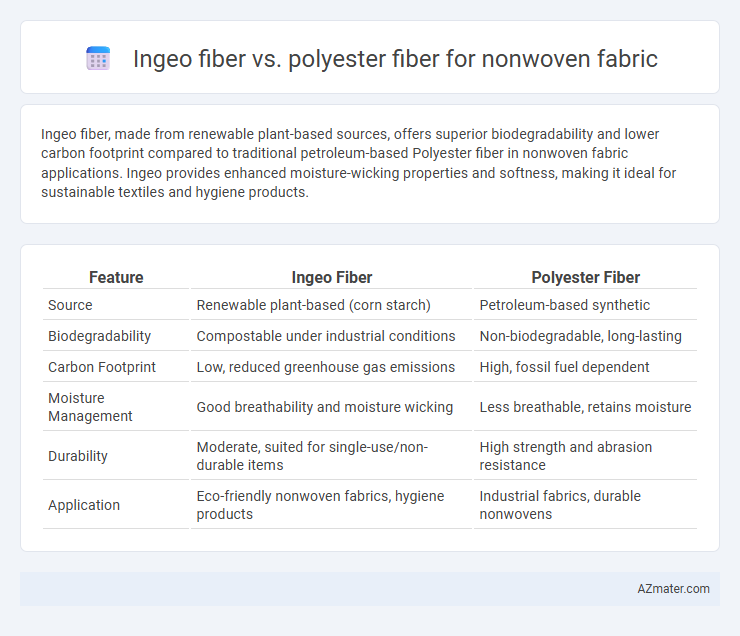Ingeo fiber, made from renewable plant-based sources, offers superior biodegradability and lower carbon footprint compared to traditional petroleum-based Polyester fiber in nonwoven fabric applications. Ingeo provides enhanced moisture-wicking properties and softness, making it ideal for sustainable textiles and hygiene products.
Table of Comparison
| Feature | Ingeo Fiber | Polyester Fiber |
|---|---|---|
| Source | Renewable plant-based (corn starch) | Petroleum-based synthetic |
| Biodegradability | Compostable under industrial conditions | Non-biodegradable, long-lasting |
| Carbon Footprint | Low, reduced greenhouse gas emissions | High, fossil fuel dependent |
| Moisture Management | Good breathability and moisture wicking | Less breathable, retains moisture |
| Durability | Moderate, suited for single-use/non-durable items | High strength and abrasion resistance |
| Application | Eco-friendly nonwoven fabrics, hygiene products | Industrial fabrics, durable nonwovens |
Introduction to Ingeo Fiber and Polyester Fiber
Ingeo fiber, derived from renewable plant-based materials like corn starch, offers a sustainable alternative to traditional synthetic fibers used in nonwoven fabrics. Polyester fiber, a petroleum-based synthetic polymer, is widely recognized for its durability, moisture resistance, and cost-effectiveness in nonwoven applications. Both fibers provide unique properties: Ingeo fiber emphasizes biodegradability and eco-friendliness, while polyester fiber delivers strength and longevity, making the choice dependent on environmental priorities and end-use performance requirements.
Key Differences Between Ingeo and Polyester Fibers
Ingeo fiber, made from renewable plant-based sources like corn, offers superior biodegradability and a lower carbon footprint compared to petroleum-based polyester fiber commonly used in nonwoven fabrics. Ingeo fibers provide enhanced moisture-wicking and breathability, making them more suitable for eco-friendly textile applications, while polyester fibers excel in durability, chemical resistance, and cost-effectiveness. Key differences include Ingeo's renewable origins and compostability versus polyester's synthetic composition and higher environmental persistence, impacting sustainability and end-of-life disposal.
Raw Material Sources: Biobased vs Petroleum-Based
Ingeo fiber is derived from renewable biobased sources such as corn starch, offering a sustainable alternative to traditional synthetic fibers. Polyester fiber is made from petroleum-based raw materials, relying heavily on fossil fuels and non-renewable resources. The biobased origin of Ingeo fiber supports reduced carbon footprint and enhanced environmental benefits compared to the petroleum-based production of polyester fiber.
Environmental Impact and Sustainability
Ingeo fiber, derived from renewable plant-based resources like corn, offers a significantly lower carbon footprint and biodegradability compared to petroleum-based polyester fiber used in nonwoven fabrics. Polyester fiber production involves high energy consumption and reliance on fossil fuels, contributing to greenhouse gas emissions and microplastic pollution. Ingeo's compostability and reduced environmental impact position it as a sustainable alternative for eco-friendly nonwoven textile applications.
Performance Characteristics: Strength, Durability, and Softness
Ingeo fiber, derived from renewable plant-based sources, offers comparable strength to polyester fiber in nonwoven fabrics while providing enhanced softness and a more natural hand feel. Polyester fiber excels in durability and resistance to wear, maintaining structural integrity under repeated stress and exposure to moisture. The choice between Ingeo and polyester fibers depends on the specific application requirements, balancing biodegradability and comfort against long-term durability and strength.
Processing and Manufacturing Considerations
Ingeo fiber, derived from renewable plant-based sources, processes at lower temperatures than polyester fiber, reducing energy consumption and thermal degradation during nonwoven fabric manufacturing. Polyester fiber offers high thermal stability and consistent melting points, enabling rapid processing and superior mechanical bonding in nonwoven applications. Choosing Ingeo fiber supports eco-friendly production with biodegradable properties, whereas polyester fiber excels in durability and moisture resistance for industrial-scale manufacturing.
Cost Comparison: Ingeo Fiber vs Polyester Fiber
Ingeo fiber typically incurs higher raw material costs compared to polyester fiber due to its bio-based origin and renewable sourcing, impacting the overall price of nonwoven fabrics. Polyester fiber benefits from established mass production processes and lower petroleum-based raw material costs, resulting in more affordable fabric options. However, potential savings in environmental compliance and end-of-life disposal costs may offset Ingeo's higher initial price in some applications.
Applications in Nonwoven Fabrics
Ingeo fiber, derived from renewable plant-based sources, offers superior biodegradability and breathability compared to conventional polyester fiber, making it ideal for eco-friendly nonwoven fabric applications such as hygiene products, medical textiles, and filtration materials. Polyester fiber, known for its durability, strength, and resistance to moisture, remains the preferred choice in industrial nonwovens, geotextiles, and automotive interiors where longevity and performance under stress are critical. The selection between Ingeo and polyester fibers largely depends on the balance between environmental impact and functional requirements in nonwoven fabric manufacturing.
Consumer Perceptions and Market Trends
Ingeo fiber, derived from renewable plant-based sources, appeals to environmentally conscious consumers seeking sustainable and biodegradable alternatives to traditional polyester fiber in nonwoven fabrics. Market trends show increasing demand for eco-friendly textiles, driving growth in Ingeo fiber adoption due to its lower carbon footprint and compostability. Consumer perceptions favor Ingeo for its natural origin and reduced environmental impact, contrasting with polyester's association with petrochemical production and microplastic pollution.
Future Outlook for Nonwoven Fabrics
Ingeo fiber offers a promising future for nonwoven fabrics due to its renewable, biodegradable nature, and lower carbon footprint compared to petroleum-based polyester fiber. Innovations in bio-based Ingeo fiber enhance material sustainability, meeting increasing industry and consumer demand for eco-friendly products. Emerging trends suggest a growing adoption of Ingeo fiber in hygiene, medical, and filtration nonwoven applications driven by regulatory pressure and environmental awareness.

Infographic: Ingeo fiber vs Polyester fiber for Nonwoven fabric
 azmater.com
azmater.com